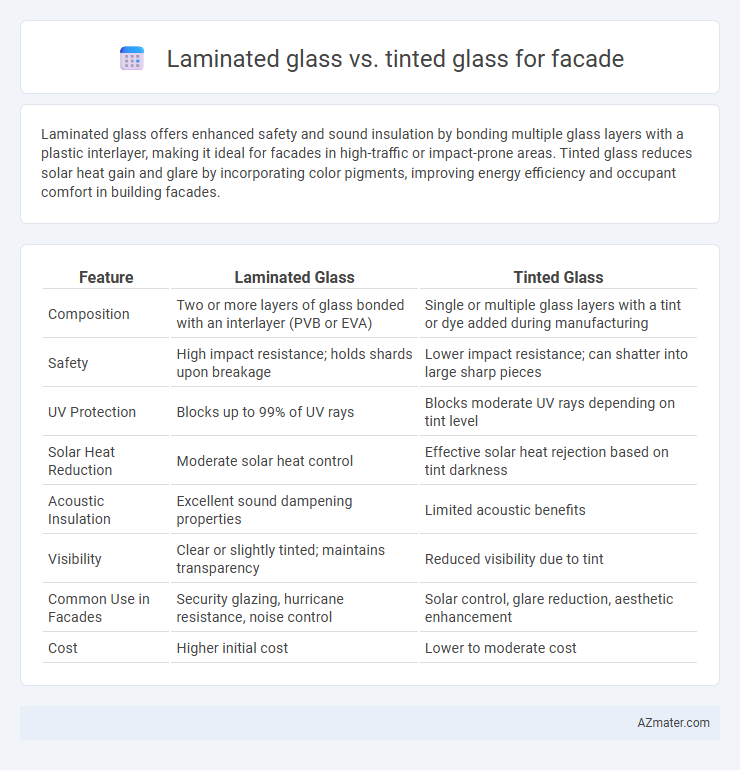Laminated glass offers enhanced safety and sound insulation by bonding multiple glass layers with a plastic interlayer, making it ideal for facades in high-traffic or impact-prone areas. Tinted glass reduces solar heat gain and glare by incorporating color pigments, improving energy efficiency and occupant comfort in building facades.
Table of Comparison
| Feature | Laminated Glass | Tinted Glass |
|---|---|---|
| Composition | Two or more layers of glass bonded with an interlayer (PVB or EVA) | Single or multiple glass layers with a tint or dye added during manufacturing |
| Safety | High impact resistance; holds shards upon breakage | Lower impact resistance; can shatter into large sharp pieces |
| UV Protection | Blocks up to 99% of UV rays | Blocks moderate UV rays depending on tint level |
| Solar Heat Reduction | Moderate solar heat control | Effective solar heat rejection based on tint darkness |
| Acoustic Insulation | Excellent sound dampening properties | Limited acoustic benefits |
| Visibility | Clear or slightly tinted; maintains transparency | Reduced visibility due to tint |
| Common Use in Facades | Security glazing, hurricane resistance, noise control | Solar control, glare reduction, aesthetic enhancement |
| Cost | Higher initial cost | Lower to moderate cost |
Introduction to Facade Glass Options
Laminated glass for facades offers enhanced safety by holding shattered pieces together, while providing sound insulation and UV protection. Tinted glass reduces solar heat gain and glare, improving energy efficiency and occupant comfort through its coloration. Both options contribute to aesthetic appeal and performance, allowing architects to balance security, energy savings, and design in building facades.
What is Laminated Glass?
Laminated glass consists of two or more glass layers bonded together with an interlayer, typically made of polyvinyl butyral (PVB), providing enhanced safety and security for facades. This construction prevents shattering upon impact, reducing the risk of injury and improving durability against environmental elements. Compared to tinted glass, laminated glass offers superior noise reduction and UV protection, making it an ideal choice for building facades requiring safety and energy efficiency.
What is Tinted Glass?
Tinted glass for facades is specially treated to reduce solar heat gain and glare by adding color or metallic oxides during production, enhancing energy efficiency and occupant comfort. Laminated glass, by contrast, consists of multiple layers bonded with an interlayer, offering superior safety, sound insulation, and UV protection but does not inherently reduce light transmission like tinted glass. Choosing tinted glass improves facade aesthetics and climate control, while laminated glass prioritizes structural integrity and safety performance.
Key Differences Between Laminated and Tinted Glass
Laminated glass consists of two or more glass layers bonded with an interlayer, enhancing safety by holding shards together upon breakage and providing superior sound insulation for building facades. Tinted glass contains additives or films that reduce solar heat and glare by absorbing visible light, improving energy efficiency but offering less impact resistance than laminated glass. The primary distinction lies in laminated glass's safety and structural benefits versus tinted glass's focus on solar control and aesthetic variation for facades.
Safety and Security Comparison
Laminated glass offers superior safety benefits for facades due to its multiple layers bonded with a strong interlayer that holds shards together upon impact, reducing the risk of injury and intrusion. Tinted glass primarily enhances privacy and glare reduction but lacks the structural strength and shatter resistance critical for security purposes. For high-security facades, laminated glass provides enhanced protection against forced entry, ballistic impacts, and severe weather, making it the preferred choice over tinted glass.
Energy Efficiency: Laminated vs Tinted Glass
Laminated glass enhances energy efficiency by providing superior insulation and reducing heat transfer through its multiple layers bonded with an interlayer, which also improves UV protection and sound insulation. Tinted glass decreases solar heat gain by absorbing and reflecting a portion of sunlight, thus lowering cooling costs but potentially reducing natural daylight. Selecting laminated glass for facades prioritizes thermal performance and safety, while tinted glass focuses on controlling glare and solar heat, impacting overall building energy consumption differently.
Acoustic Performance in Facade Applications
Laminated glass offers superior acoustic insulation in facade applications due to its interlayer that dampens sound vibrations, significantly reducing external noise transmission. Tinted glass primarily enhances solar control and glare reduction but provides limited soundproofing benefits compared to laminated glass. Choosing laminated glass improves overall acoustic comfort in buildings facing high traffic or noisy urban environments.
Aesthetic and Design Flexibility
Laminated glass offers enhanced safety with its multi-layer composition while maintaining high optical clarity, allowing architects to incorporate intricate designs and customized colors for facades. Tinted glass provides effective solar control and privacy with varying shades, enabling designers to create visually striking exteriors that reduce glare and heat gain. Both options expand aesthetic possibilities, but laminated glass excels in layering effects and structural creativity, whereas tinted glass emphasizes energy efficiency and subtle color variations for facade applications.
Cost Considerations and Installation
Laminated glass typically costs more than tinted glass due to its complex manufacturing process involving multiple layers and interlayers that enhance safety and sound insulation. Installation of laminated glass requires specialized handling and adhesives to maintain structural integrity, often increasing labor expenses compared to tinted glass, which is simpler to install as a single layer treated for solar control. Choosing between laminated and tinted glass depends on balancing upfront material costs with long-term benefits like durability, energy efficiency, and maintenance requirements in facade applications.
Choosing the Right Glass for Your Facade
Laminated glass offers enhanced safety and sound insulation by sandwiching a polyvinyl butyral (PVB) layer between glass sheets, making it ideal for facades requiring impact resistance and noise reduction. Tinted glass reduces solar heat gain and glare through embedded metal oxides, improving energy efficiency and occupant comfort in sun-exposed facades. Selecting the right glass depends on balancing security needs, energy performance goals, and aesthetic preferences for optimal facade functionality.

Infographic: Laminated glass vs Tinted glass for Facade
 azmater.com
azmater.com